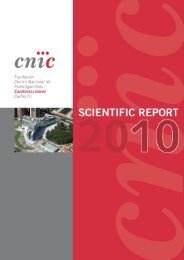Appendix - CNIC
Appendix - CNIC
Appendix - CNIC
Create successful ePaper yourself
Turn your PDF publications into a flip-book with our unique Google optimized e-Paper software.
SCIENTIFIC REPORT ´09 7 Technical Units<br />
Viral vectors<br />
> RESEARCH INTEREST<br />
Head of Unit: Juan Carlos Ramirez<br />
Research Scientist: Raúl Torres<br />
Predoctoral Researcher: Zita Garate<br />
Technician: Aida Garcia<br />
The Viral Vectors facility develops efficient recombinant<br />
viruses and strategies for gene transfer, using cloning<br />
strategies based both on restriction enzymes and on<br />
recombinases (cre, clonaseTM ). The viral stocks currently<br />
produced, purified and titrated at the facility are second and<br />
third generation lentiviruses; eco-, ampho- and xenotropic<br />
pseudotyped retroviruses, and Ad5∆E1a–derived<br />
adenoviruses. Our quality control procedures include<br />
replication competent particle assays. In addition to cDNAencoding<br />
gain-of-function vectors, we design vectors for lossof-function<br />
studies encoding Pol II/Pol III-driven miRNAs or<br />
shRNAs. Lentivectors designed to drive cre-mediated<br />
expression of shRNAs for in vitro and in vivo studies are also<br />
available. We are currently developing capacity for the<br />
production of Ad-gutless and Adeno-associated viruses (AAV)<br />
pseudotyped with 2, 8 and 9 capsids to enable targeted<br />
delivery in vivo.<br />
We also conduct our own technical and basic research<br />
programs. Technical research projects include 1) the<br />
development of novel tools based on non-integrative lentivirus<br />
for efficient homologous recombination at specific loci in<br />
mouse or human embryonic stem cells; 2) development of<br />
strategies for the safe production of induced pluripotent stem<br />
cells; and 3) the establishment of miRNA-based positive<br />
sensor systems that will allow identification and selection of<br />
subsets of native and induced stem cells with specific<br />
pluripotencies and differentiation potentials. In collaboration<br />
with the Comparative Medicine Unit (Experimental Surgery<br />
Core) we are also implementing methods for efficient in vivo<br />
delivery of lenti- and adeno-vectors to the heart.<br />
Our basic research is currently focused on how the gene for<br />
the chemokine SDF-1γ is specifically transcribed in heart cells<br />
to drive nucleolar localization of the protein. To characterize<br />
the role of this unprecedented feature and to define the<br />
expression profile of cardiac SDF-1γ during development, we<br />
are developing in vivo RNAi strategies using tetraploid<br />
embryos and conditional knockout mice.<br />
86<br />
The carboxy terminus of SDF-1γ contains a nucleolar<br />
localization signal that targets the protein (fused to<br />
cerulean fluorescent protein) to the nucleoli of<br />
transfected human cells, labeling them blue.



